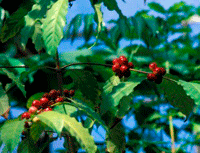

Coffea canephora (Robusta Coffee; syn. Coffea robusta) is a species of coffee which has its origins in western Africa. It is grown mostly in Africa and Brazil, where it is often called Conillon. It is also grown in Southeast Asia where French colonists introduced the crop to Vietnam in the late 19th century and now has exports second to Brazil.
It is easier to care for than Coffea arabica and hence is cheaper to produce. Since arabica beans are considered superior, robusta is usually limited to lower grade coffee blends as a filler. It is however included in instant coffee, and in espresso blends to promote the formation of "crema". Robusta has about twice the amount of caffeine compared to arabica. Approximately one third of the coffee produced in the world is robusta.
Coffea canephora was not classified as a species of Coffea until about a hundred years after Coffea arabica in the 18th century, but grew indigenously in Western and Central Africa. The plant has a shallow root system and grows as a robust tree or shrub to about 10 metres. It flowers irregularly taking about 10 - 11 months for cherries to ripen, producing oval shaped beans. The Robusta plant has a greater crop yield than that of Arabica and is less susceptible to pest and disease, but is said to a have a taste more bitter than Arabica.
Image Source: The Banana Tree
The Plant
The Plant Overview | Plant Growth | Arabica vs Robusta | Arabica Coffee
Arabica Varietals | Growing Coffee at Home



















































